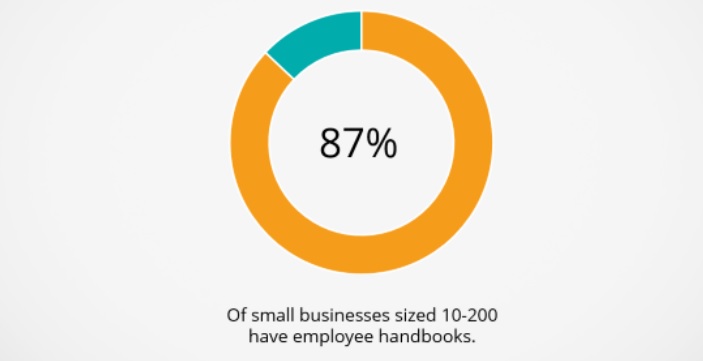
Articles
Are Companies Required to Have an Employee Handbook?

Are companies required to have an employee handbook? It's a question that has been asked countless times by small-to-medium-sized businesses, entrepreneurs, founders, and managers alike. While the answer may not be as straightforward as some would like it to be, understanding the importance of having one is key to developing your business.
In this blog post, we will explore why are employee handbooks important, if it's necessary for your company to have a well-crafted employee handbook, and how to create an effective employee manual with best practices for implementation.
So are companies required to have an employee handbook? Read on and find out.
Are Companies Required to Have an Employee Handbook?
Employee handbooks are essential for businesses of all sizes. They define company policies and list procedures for addressing employee questions and issues, helping to prevent conflicts down the line. But if you’re not sure whether are companies required to have an employee handbook, here are a few things to consider.
Company Size
If you have more than 25 employees, it’s important to have an employee handbook in place. This is especially true if you employ people in different states or countries as laws can vary according to jurisdiction.
Compliance
Employee handbooks help ensure that your business complies with federal, state, and local employment laws. An HR outsourcing company can help make sure your policies are up-to-date and compliant with current regulations.
Policies and Procedures
A well-written employee handbook will clearly outline the expectations of both employers and employees when it comes to workplace behavior, attendance requirements, and job duties. This helps create a positive work environment where everyone knows what is expected of them. It also provides guidance on how disputes should be handled so they don't escalate into larger problems.
Onboarding and Training
Having a well-crafted employee handbook makes onboarding new hires easier by providing them with clear guidelines about their roles within the organization. It also serves as a great training tool for existing staff members who may need refreshers on certain topics such as safety protocols or customer service standards.
A well-written employee handbook saves businesses time and money by preventing misunderstandings in employment relationships while creating a safe space for productive conversations.
What to Include in a Company’s Employee Handbook
A compliant employee handbook will include the following sections:
- Company culture and mission statement.
- Anti-discrimination and harassment policies.
- Acceptable use policy (for technology).
- Vacation/leave policies.
- Sick days.
- Overtime pay.
- Disciplinary actions.
- Termination procedures.
- Grievance process.
- Safety protocols.
Depending on your industry, there may be additional topics included such as data security measures or privacy laws applicable to your business operations which need special attention when creating a strong employee handbook. Therefore, it is important to consult with legal counsel before finalizing your document.
Benefits of Having a Staff Handbook
Even if there aren’t any legal requirements mandating that you create an employee manual, having one still has many benefits.
A comprehensive policy document can help ensure consistency throughout your organization by providing clear guidelines on everything from dress code and attendance to vacation days and overtime pay rates. A strong employee handbook protects both employers and employees by setting expectations upfront so everyone knows what is expected of them in the workplace.
Failing to create a company’s employee handbook could leave your business open to potential liability issues if disputes arise between management and staff members over unclear rules or procedures.
Not having a written set of policies also makes it difficult for new hires or seasonal workers who may not be familiar with how things work at your company, potentially leading them to make mistakes.
While creating an employee handbook is not legally required, it has plenty of benefits for you and your employees. So, how do you create a well-crafted, comprehensive handbook?

How to Create an Effective Employee Handbook
The first step in creating a well-written handbook is to identify all relevant policies that need to be included. This includes topics such as workplace safety, workplace conduct, attendance policy, overtime regulations, remote work policy, performance reviews, occupational safety, and more.
Once you have identified the topics that need to be addressed in your handbook, it’s time to start writing them down. Be sure to include details about each policy so there is no room for misinterpretation or confusion.
When writing out your policies and procedures in the employee handbook, make sure they are easy to understand. Avoid using jargon or technical/legal terms. Focus on making sure everyone understands what is expected of them at work.
Provide examples where necessary so employees know exactly what kind of behavior will not be tolerated within the organization.
To ensure your employee handbook remains up-to-date and compliant, review all existing policies every year and update them accordingly.
Keep track of any feedback from employees regarding their experience with specific policies. This could help you identify areas where further clarification might be needed before updating those sections.
What Happens When an Employer Doesn’t Have a Handbook?
If an employer doesn’t have an employee handbook or personnel policies in place, it can be a huge problem. Without clear expectations and guidelines for employees to follow, the company is vulnerable to lawsuits and legal liability. It also leaves workers feeling uncertain about their rights as employees and what is expected of them.
Without a handbook or policy manual, employers won't be able to provide proper onboarding for new hires. This could mean that new employees don’t receive the necessary training they need to do their job correctly or safely.
Additionally, without established procedures in place, there may be no way for management to address issues such as harassment or discrimination if they arise within the workplace.
Not having an employee handbook can also lead to confusion when it comes to performance reviews and raises since there are no set criteria by which these decisions are made.
Without clearly defined policies regarding attendance, vacation days, and sick leave, workers may feel like they don’t have any recourse if their requests are denied unfairly or inconsistently.
Finally, without an employee handbook outlining termination procedures and how final paychecks should be issued, companies risk leaving themselves open to potential litigation due to improper handling of wages or benefits packages of exiting employees.
Having a comprehensive employee handbook with legally-sound personnel policies is essential for businesses of all sizes so that everyone knows exactly what is expected of them during employment and after leaving the organization.
Conclusion
So, are companies required to have an employee handbook?
No, businesses are not required to have an employee handbook as long as they inform employees of their rights in the workplace.
However, having an up-to-date employee handbook is a great way for companies to demonstrate their commitment to providing a safe work environment for their employees while ensuring everyone understands what is expected of them.
Are you an entrepreneur, founder, manager, or operational leader looking for a comprehensive solution to grow and scale your business? Trainual is here to help! Our platform provides the tools needed to document processes and policies and deliver superior onboarding, offboarding, and training experiences.
With our intuitive software, companies are not only able to create compliant employee handbooks quickly but also maintain them as their businesses evolve over time. Sign up today with Trainual!
Similar Blog Posts







